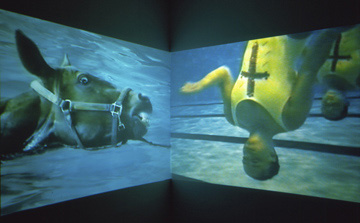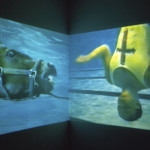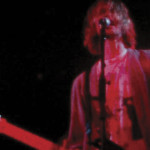By ARTHUR WHITMAN
Even though Stop. Look. Listen. represents the culmination of a half-decade's worth of dedicated video-collecting at the Johnson, it has the feel of something out of the blue. Moving images fill most of the modest museum's temporary exhibition space. The two underground levels are filled with a maze of temporary mini-theaters. Screens spill out into the lobby. At night, projections color the building facade (this has actually been something of a Johnson tradition, although mainstream Hollywood movies are as common as art videos). The overall effect is audacious but at times awkward.
The show suffers from common difficulties faced by video shows in museums and galleries. Although many pieces use headphones, this isn't enough to prevent the profusion of distracting ambient noise. Pieces loop on different schedules, making it difficult to hop from one piece to another. (Although the general absence of linear narrative makes this less of a problem.) And the impulse of many of the artists to create "immersive", cinema-like projection rooms doesn't do justice to the monumental spaces of the Johnson's I.M. Pei designed building.
The work itself is a mixed bag, ranging from the gimmicky innuendo (non-explicit) of Mads Lynnerup's Untying a Shoe with an Erection to works of real poetry and power.
Mircea Cantor's soundless Deeparture is the show's standout piece. The projected video is shown in one of the largest mini-theaters, a white box in contrast to so many black boxes. This choice was well-planned, because the piece itself takes place in a room that is similarÑalbeit much more brightly lit. We feel the echoing of the real and depicted spaces. Two animalsÑa white wolf and a deerÑare the only inhabitants. They circle around in a tense dance, eyeing each other. The camera shifts perspectives, often looking down to face the wolf. There is some camera blurring but the overall effect is one of extreme lucidity. We see the animals' gestures and movements with unaccustomed sharpness.
Amy Jenkins' sculpture and projection piece Ebb is also rich. A small white clawfoot bathtub sits on a low table covered in hexagonal tiles, also white. These sculptural elements are the piece's main weaknesses; I was left wanting more color or texture. At the beginning, we see the tub filled with bloody water; soon a translucent woman climbs in. She breathes, blows bubbles, splashes water, and rubs her body, actions we can hear as well as see. We hear a dull heartbeat thump grow softer and louder. Gradually and disturbingly, her body seems to absorb the blood, until near the end the water is cleansed. She then steps out. Aside from her entrance and her exit, she appears confined within the tub's space. The projection is clear against the tub bottom and against the gently sloping side where the woman rests her head. On the other three sides (steeper), it is indistinct. We see the tub from above, which adds to the piece's voyeuristic quality.
Several pieces incorporate singing, which tends to bring up comparisons to the music video. Using an actor accomplice, Slater Bradley's Doppelganger Trilogy does little more than successfully mimic their style. It consists of three separate pieces, each on an adjacent wall-mouned screen and each featuring a different pop star imposture. Their presentations are predictably cliched. In Factory Archives a brooding, difficult to decipher Ian Curtis (Joy Division) doppelganger does a stiff little dance and sings into the microphone. The camera is still and the footage is very grainy and nearly monochrome. In contrast, Phantom Release shows a tousle-haired Kurt Cobain impersonator wildly flailing around backed by faceless bandmates. Red and blue stage lighting coats the scene. As with many music videos the conceit in these two works is that matching song (which can be heard on headphones) is being produced by the actor shown. The black and white Recorded Yesterday features "Michael Jackson" (hat over eyes) engaged in suitably ridiculous choreography on an empty stage. The piece is the most daring of the three. Painterly white and textured shapes flicker over the performer. Unlike the other two videos, there are no headphones and no soundtrack.
Amy Globus' Electric Sheep (another projection room) provides a more imaginative use of vocal music. The juxtaposition of Emmylou Harris singing her plaintive ballad "Wrecking Ball" alongside gorgeous shots of an octopus swimming around in a maze of glass cases is unexpected without being arbitrary. The music is punctuated by incongruous bursts of feedback noise, adding tension. The repeated lyric "I'll wear something pretty" is oddly appropriate given the visuals, which are grotesque but also deeply sensuous. The close-ups are especially lovelyÑundulating fields of dots and the outlines of tentacles against the black background. There is variation in the framing. Especially notable is how the frame stretches wide to echo the creature as it stretches through narrow tubes.
Burt Barr's Roz and Jesper Just's Bliss and Heaven (both projections) both show vocal performance. The pieces are very different.Bliss is a film rather than a video and follows many of the conventions of traditional narrative cinema. The camerawork is dramatic but subtle. There is much use of black silhouetted figures and other forms. A young blue-collar looking man walks through wheat-fields till he comes upon a road where a trailer is being parked. He sees the muscular male driver get out of the front and pop around to the back of his vehicle. He follows the driver in. At first the interior is pitch black, but then there is a spotlight and the scene is shown magically to be an enormous, baroque theater. The diver has been transmogrified into a blond-wigged drag queen onstage. She sings a baritone rendition of the disco hit "Please Don't Keep Me Waiting" by Olivia Newton John. The resulting audience-performer interaction is intimate but distanced, literally and otherwise. The short film is campy but not without a real emotional charge.
In sharp contrast to Just's cinematic bombast, Barr's video shows a simple event without the camera moving. A young woman showers while lip-synching to Otis Clay's R&B ballad "The Banks of the Ohio". We see her face straight-on and occasionally her arms and hands as she brushes through her black, plaited hair. She dances around a bit. Her facial expressions seem calculatedly masculine. Roz's theatrical gender bending sustains no more than brief interest.
Janet Briggs' Water Training is a split projection divided awkwardly by a room corner. On the left is a bridled race horse training by treading blue-green water. We see its head poking above water. He twitches and grunts and shakes.To the right are a sequence of young women in a pool, doing synchronized swimming. We see them from underneath the bluish water (occasionally their heads disappear when they go up for air). For the most part, they are at a remove of several feet. Women appear and disappear. We see different body builds and different color swimsuits. Usually we see a pair, at one point there is a crowd. The piece fails to provide the expected visual and kinesthetic excitement. The accompanying sounds are indistinct.
- Janet Biggs, Water Training, 1997
- Slater Bradley, Still from Phantom Release, 2003
- Mircea Cantor, Still from Deeparture, 2004
The Herbert F. Johnson Museum Of Art at Cornell University
"Stop. Look. Listen: An Exhibition of Video Works" is on view October 13 - December 23 at the Herbert F. Johnson Museum of Art in Ithaca, NY.
All images are courtesy of the Johnson Museum website.







